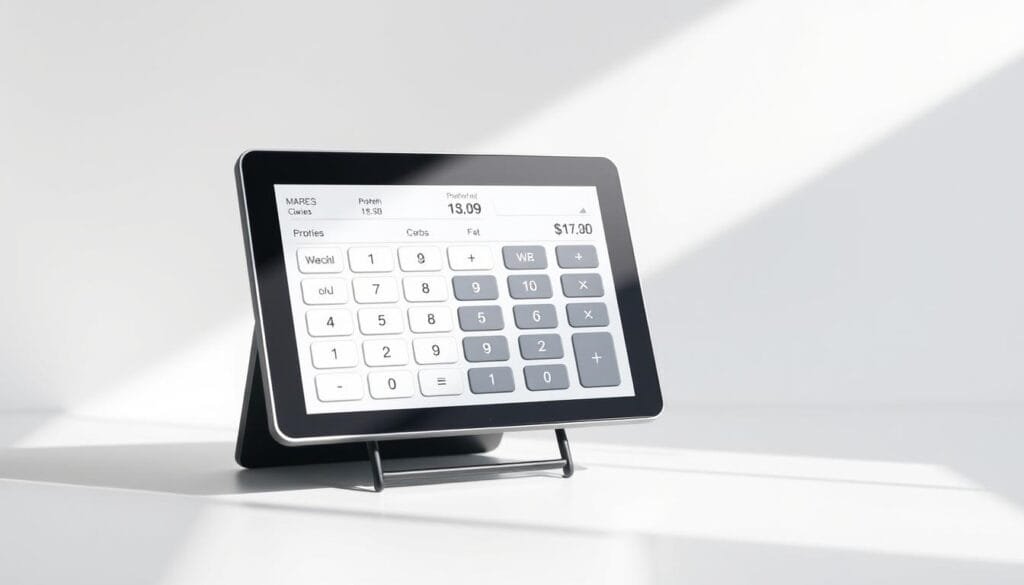How to track your macros for weight loss is a powerful strategy that goes beyond simple calorie counting. This method focuses on balancing carbohydrates, protein, and fat to optimize weight loss results.
Macronutrients, or macros, are the main energy sources in our food. By learning how to track your macros for weight loss, you can improve your diet and make better food choices.
This approach helps prioritize nutrient quality, not just calorie intake. It ensures you achieve the right macro balance to support fat loss while maintaining muscle and overall health.
Let’s explore the basics of macro tracking and how it can boost your weight loss journey. You’ll discover how to calculate your ideal macro ratios and get practical tips to make this method work for you.
Key Takeaways
- Macro tracking focuses on balancing carbohydrates, protein, and fat for weight loss
- This method emphasizes nutrient quality over simple calorie counting
- Understanding macronutrients helps optimize your diet for weight loss success
- Macro tracking can be personalized to fit your specific weight loss goals
- Balancing macros ensures proper nutrition while losing weight
Understanding Macronutrients and Their Role in Weight Loss
Macronutrients are the building blocks of our diet. They include carbohydrates, proteins, and fats. Each type helps our body work and manage weight.
What Are Macronutrients
Macronutrients are nutrients our bodies need in large amounts. They give us energy and help our bodies work. The three main types are:
- Carbohydrates: 4 calories per gram
- Proteins: 4 calories per gram
- Fats: 9 calories per gram
Why Macros Matter for Weight Loss
Tracking macros can help you lose weight. It shows what you’re eating and how it affects your body. A good macro balance keeps you full and helps burn fat.
The Science Behind Macro Balance
The right macro balance can help you lose weight better. Here’s a guide for macro ratios:
| Macronutrient | Recommended Percentage |
|---|---|
| Carbohydrates | 45-65% of daily calories |
| Proteins | 10-35% of daily calories |
| Fats | 20-35% of daily calories |
These ratios can change based on what you need. Some diets use different amounts of each macro. Find a balance that works for you and helps you lose weight.
How to Track Your Macros for Weight Loss
Tracking macros can boost your weight loss efforts. I’ll show you how to calculate calories, set macro ratios, and use apps for easy tracking.
Calculating Your Daily Caloric Needs
First, determine your daily calorie needs. The Mifflin-St. Jeor equation is a trusted calorie calculator. It uses your age, height, weight, and activity level.
For weight loss, eat fewer calories than you burn. This creates a calorie deficit, helping you shed pounds.

Determining Your Ideal Macro Ratios
Your macro ratio is key for weight loss. A common split is 45-65% carbs, 20-35% fats, and 10-35% proteins.
For a 2000-calorie diet with a 50/30/20 ratio, aim for:
- 250g carbs (1000 calories)
- 150g proteins (600 calories)
- 45g fats (400 calories)
Remember: 1g of carbs or protein equals 4 calories. 1g of fat equals 9 calories.
Tools and Apps for Macro Tracking
Tracking apps simplify macro counting. Popular choices include My Macros+, MyFitnessPal, and Carb Manager. These apps help log food and track progress.
Use a digital food scale with these apps for accuracy. This combo sets you up for weight loss success!
Essential Macronutrient Ratios for Different Goals
Macronutrient ratios are key to reaching fitness goals. Let’s explore ideal ratios for weight loss, muscle gain, and maintenance. These will help you create a better nutrition plan.
For weight loss, try 45% protein, 30% carbs, and 25% fat. This helps keep muscle while burning fat. Another option is 50% carbs, 35% protein, and 15% fat.
Muscle gain needs more carbs. Aim for 55-65% carbs, 20-30% protein, and 25-30% fat. This works well for medium to high-intensity training.
Maintenance macros should be balanced. USDA suggests 45-65% carbs, 10-35% protein, and 20-35% fat. This range lets you adjust based on your needs and activity.
| Goal | Protein | Carbs | Fat |
|---|---|---|---|
| Weight Loss | 45% | 30% | 25% |
| Muscle Gain | 25% | 60% | 15% |
| Maintenance | 20% | 50% | 30% |
These ratios are just starting points. Your ideal mix may change based on your body and activity. Keep track of your progress and make changes as needed.
Common Foods and Their Macro Profiles
Knowing food macronutrients is vital for macro tracking. Let’s look at common food sources for each macronutrient. We’ll see how they fit into balanced meals.
Protein-Rich Food Sources
High-protein foods help muscles grow and repair. Here are some great protein sources:
- Chicken breast (31g protein per 100g)
- Greek yogurt (10g protein per 100g)
- Eggs (6g protein per large egg)
- Salmon (22g protein per 100g)
- Lentils (9g protein per 100g cooked)
Healthy Carbohydrate Options
Complex carbs give lasting energy and fiber. Try these healthy carb choices:
- Quinoa (21g carbs per 100g cooked)
- Sweet potatoes (20g carbs per 100g)
- Oats (66g carbs per 100g dry)
- Brown rice (23g carbs per 100g cooked)
- Apples (14g carbs per medium apple)
Quality Fat Sources
Healthy fats balance hormones and help absorb nutrients. Check out these fat options:
- Avocado (15g fat per 100g)
- Almonds (49g fat per 100g)
- Olive oil (100g fat per 100ml)
- Chia seeds (31g fat per 100g)
- Salmon (13g fat per 100g)
Balanced Meal Examples
Balanced meals mix foods from each macro group. Here’s a tasty example:
- Grilled chicken breast (protein)
- Quinoa (complex carbs)
- Roasted vegetables (carbs and fiber)
- Avocado slices (healthy fats)
This meal balances protein, complex carbs, and healthy fats. It’s great for weight loss or muscle gain.

Practical Tips for Successful Macro Tracking
Macro tracking can revolutionize your weight loss journey. These tips will help you master this technique and reach your goals.
Check This:
- 10 Essential Tips on How to Follow a Macro Diet for Success
- 7 Simple Steps on How to Eat a Macro Diet for Optimal Nutrition
Meal Planning Strategies
Meal prep is crucial for effective macro tracking. Try batch cooking proteins and complex carbs on weekends. This saves time and ensures you have macro-friendly meals ready.
Create a weekly meal plan with balanced options. Focus on lean proteins, healthy fats, and fibrous carbs.
Portion Control Methods
Understanding portion sizes is key for accurate macro tracking. Use these simple guidelines:
- A palm-sized portion for proteins (about 30-33 grams)
- A cupped hand for carbs
- A thumb-sized portion for fats
- Two fists of vegetables
Macro Tracking Tips
To make macro tracking easier:
- Use a food scale for accuracy
- Log meals in advance
- Keep a list of go-to meals for busy days
- Customize your tracking app to fit your eating habits
Common Tracking Mistakes to Avoid
Watch out for these pitfalls:
- Forgetting to track cooking oils and sauces
- Eyeballing portions instead of measuring
- Not accounting for alcohol calories
- Neglecting to adjust macros as your weight changes
Consistency is vital for success. Stick to your plan, but don’t worry about small changes. With practice, macro tracking will become easier.
You’ll soon reach your weight loss goals effectively. Keep going and trust the process.
| Macronutrient | Calories per gram | Recommended intake range |
|---|---|---|
| Protein | 4 | 15-35% of total calories |
| Carbohydrates | 4 | 40-60% of total calories |
| Fat | 9 | 20-40% of total calories |
Making Macro Tracking Sustainable
Flexible dieting is key to sustainable macro tracking. I allow myself treats within my macro goals. This helps me stick to my plan long-term.
I can enjoy pizza if I adjust other meals. This fits my daily targets of protein, carbs, and fats.
For long-term weight loss, I focus on nutrient-dense foods. I leave room for small indulgences. This balance helps maintain a calorie deficit without feeling deprived.
I aim to lose about 1 pound per week. If progress stalls, I adjust my calorie intake by 100 calories.
Lifestyle changes are crucial for success. I use MyFitnessPal to track my macros. It has a database of over 11 million foods.
I do weight training 3 times a week. I check my measurements weekly. Focusing on overall health makes macro tracking a sustainable tool.
Source Links
- https://www.healthline.com/nutrition/how-to-count-macros – How to Count Macros: A Step-By-Step Guide
- https://www.prevention.com/weight-loss/diets/a19804935/macros-diet/ – Everything You Need to Know Before Counting Macros for Weight Loss, Per Experts

